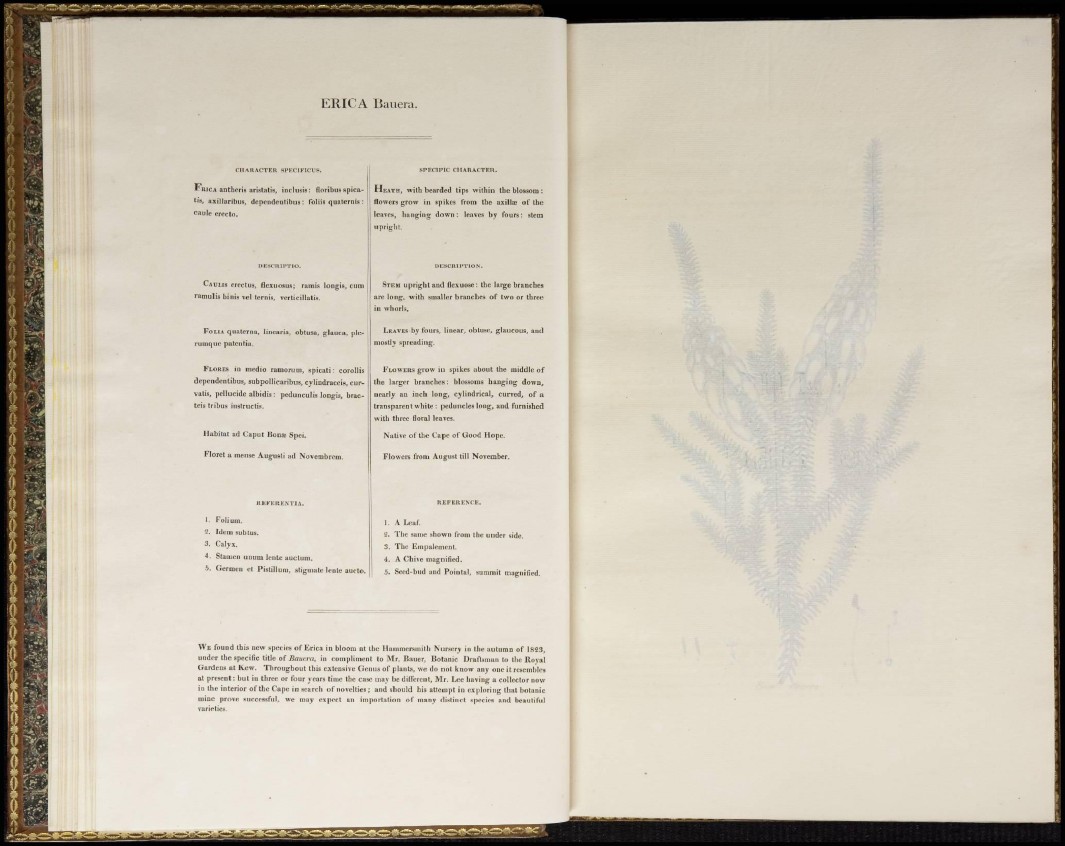
E R I C A Bauera.
CHARACTER SPECIFICU9,
'* RICA antheris aristatis, incluais: floribus spicatis,
axillaribus, dependentibus : foliis quatemis :
caule erecto.
DESCRIPTIO,
CAULIS erectus, flexuosus; rarais longis, cu
ratnulis binis vel ternis, verticillatis.
FOLIA qiiatema, linearía, obtusa, glauca, plerumque
patentia.
FLORES in medio ramorum, spicati: coroliis
dependentibus, subpollicaribus, cylindraceis, curvatis,
pellucide albidis : pedunculis longis, bracteis
tribus instructis.
Habitat ad Caput Bona; Spei.
Floret a mense Augusti ad Novembrem.
REFEREN TÍA.
1. Fobum.
'2. ídem subtus.
3. Calyx.
4. Stamen unum lente auctum.
5. Germen et Pistillum, stigmate lente aucto,
SPECIFIC CHARACTER.
HEATH, with bearded tips within the blossom :
flowers grow in spikes from the axilla; of the
leaves, hanging down; leaves by fours: stem
upright.
DESCRIPTION.
STEM upright and flexuose: the large branches
are long, with smaller branches of two or three
in whorls.
LEAVES by fours, linear, obtuse, glaucous, and
mostly spreading.
FLOWERS grow in spikes about the middle of
the larger branches: blossoms hanging down,
nearly an inch long, cylindrical, curved, of a
transparent white : peduncles long, and furnished
with three floral leaves.
Native of the Cape of Good Hope.
Flowers from August till November.
HEFEIIENCK.
1. A Leaf.
2. The same shown from the under side.
3. The Empalement.
4. A Chive magnified.
5. Seed-bud and Pointal, summit magnified.
W E found this new species of Erica in bloom at the Hammersmith Nursery in the autumn of 1823,
under the specific title of Bauera, in compliment to Mr. Bauer, Botanic Draftsman to the Royal
Gardens at Kew. Throughout this extensive Genus of plants, we do not know any one it resembles
at present: but in three or four years time the case may be difl'erent, Mr. Lee having a collector now
in the interior of the Cape in search of novelties; and should his attempt in exploring that botanic
mine prove successful, we may expect an importation of many distinct species and beautiful
varieties.